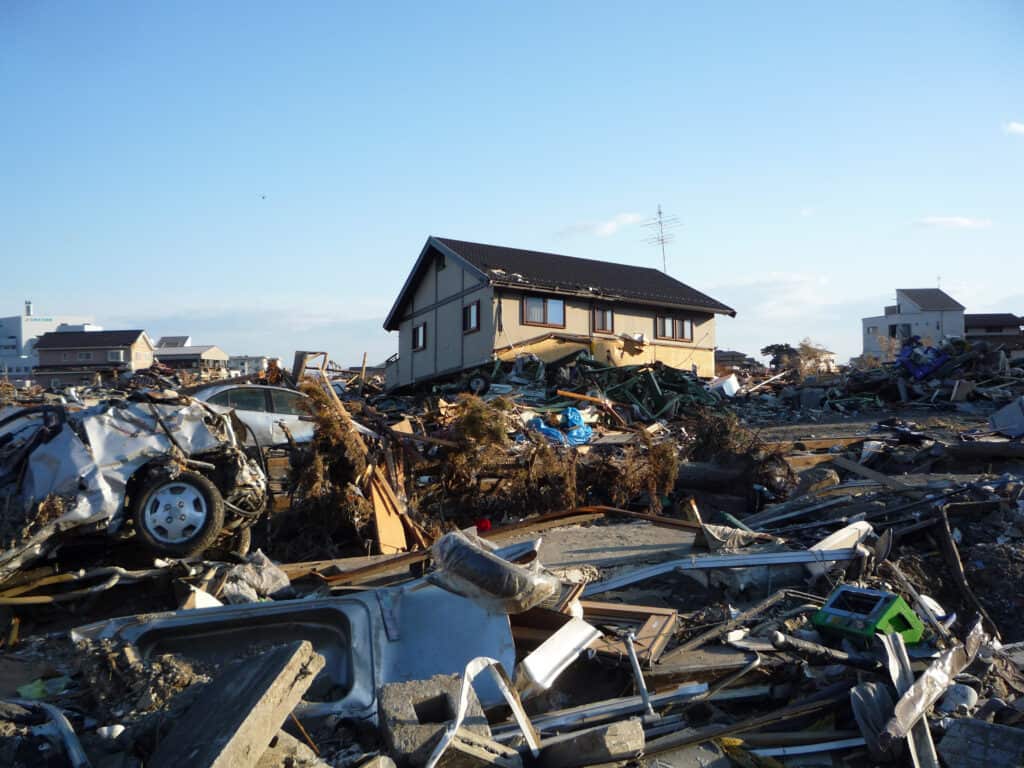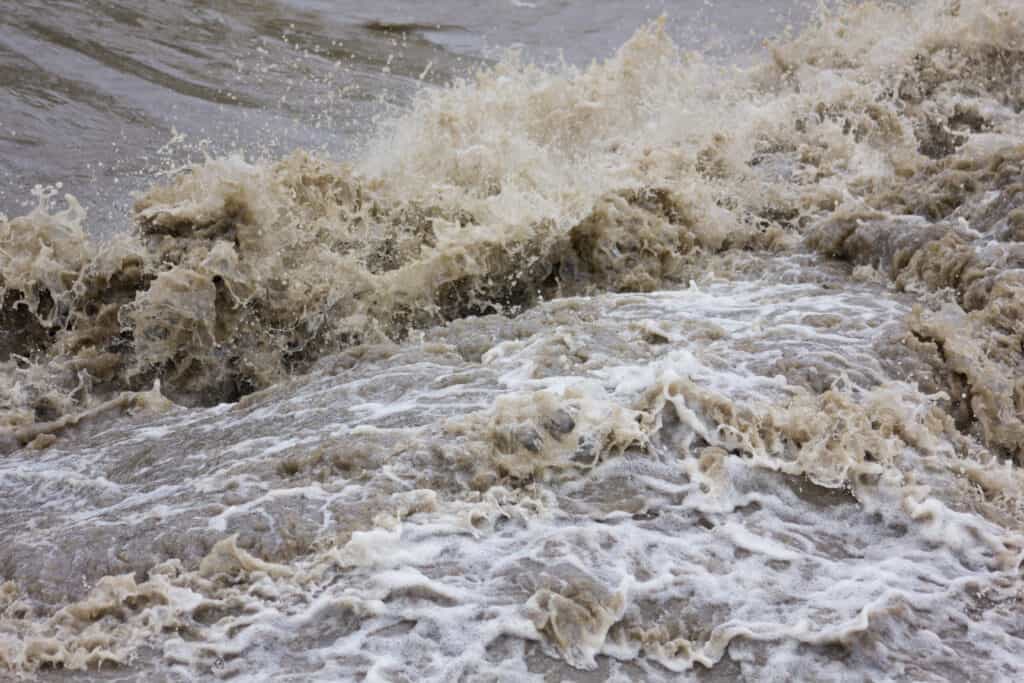Flooding results when water enters an area quickly and cannot drain, evaporate, or soak into the ground. There are many kinds of floods. Flash floods and river floods are the most common. A flash flood happens when excessive rainfall-related runoff happens quickly. This raises the water level (stage) in a stream or normally dry channel.
Dry climates and rocky terrain increase the risk of flash floods. This is because these conditions encourage torrential rainstorms to flow overland rather than seep into the ground. Greater runoff from prolonged rainstorms and occasionally from melting snow causes a slower rise in water level over a wider area. This makes river flooding more common for larger rivers in humid climates.
Although ice jams on a river or high tides can also result in flooding, storms of some kind are usually to blame for most floods. Aside from these types of floods, several things can cause them. Earthquakes, volcanoes, and even people can cause them. You’ll find out the causes of a flood, how they happen, and the effects. Keep reading to see just what causes a flood.
Earthquakes
Indirectly, earthquakes can cause flooding in several ways, such as by setting off tsunamis, making dams unstable, and breaking or lowering protective levees. Through all of these ways, the 2011 Japan earthquake caused terrible flooding. The earthquake shook the ocean floor, which caused a tsunami.
Also, parts of Japan’s coast dropped in height because of the quake, which cut up to three feet off the length of sea walls and protective levees. Barriers that were broken or lowered made the damage from the tsunami even worse. The United States has historical examples as well. For instance, the Van Norman Dam, which managed to hold back 15 million tons of water from the densely populated San Fernando Valley, sustained significant damage during the 1971 San Fernando Earthquake.
The authorities relocated tens of thousands of people out of the valley because they were concerned. The risk and pressure on the vulnerable dam were then lessened over the course of three days as they decreased the water level in the reservoir. Most modern dams are constructed to withstand large earthquakes in seismically active regions, but anyone who lives in an area where a dam could flood needs to be aware of the risks and know how to evacuate.

The 2011 Japan earthquake caused a tsunami.
©AB-DESIGN/Shutterstock.com
Volcanoes
Tsunamis can cause massive floods. Violent volcanic eruptions are another uncommon but sudden disturbance that can move a lot of water and produce tsunami waves that are extremely dangerous close to the source.
A volcanic explosion, the collapse of a volcano’s slope, or—more likely—a phreatomagmatic blast. The destruction or engulfment of the volcano’s magmatic chambers can cause sudden movement of water that results in waves. The Indonesian volcano Krakatoa (also known as Krakatau) erupted and collapsed, resulting in one of the most giant and most destructive tsunamis ever seen.
Waves up to 135 feet high were made by this explosion, which resulted in the destruction of towns and villages along the Sunda Strait’s coasts of Java and Sumatra and the deaths of 36,417 people. People also believe that the destruction of the Greek Minoan civilization in 1490 B.C. resulted from the eruption or collapse of the Santorin volcano in the Aegean Sea.
Man-Made Floods
People can cause flooding in various ways. Infrastructure that breaks or fails can result in large amounts of water flooding a local area, which can result in floods. One instance is a break in a water main, like the one that occurred in July 2014 on the UCLA (University of California, Los Angeles) campus in the United States and released 75,000 gallons of water per minute into the area.
Another instance is when dams fail because of poor design and upkeep or when they become overburdened by a lot of rain. When a region is deforested, there are no longer trees to absorb rainfall and slow the water flow across the land. Every time it rains, there is a higher risk of erosion and flooding without these natural defenses.
In developed areas, such as urban areas, there are frequently a lot of impervious surfaces, such as concrete roads and other constructions, that prevent water from soaking back into the soil. If the water is not appropriately directed after heavy rain falls on these impervious surfaces, it can build up and cause flooding in low-lying areas.
Heavy Rain
Flooding that’s caused by rain is often a flash flood. Flash floods are hazardous floods that can occur suddenly and without much warning. When there’s too much rain for the soil to hold, the extra water overflows storm drains and ditches. It then rushes into rivers and creeks, creating a flash flood. Water levels can quickly rise significantly as a result of flash floods.
Various weather conditions can bring on extreme rainfall in a region. In some tropical and subtropical areas, cyclones develop, usually in the summer and fall. They are known as hurricanes when they grow to a certain intensity in the Atlantic Ocean or the northwest Pacific Ocean. Once a tropical cyclone reaches land, it can drop enormous amounts of rain, leading to flash flooding and flooding in general.
They can also cause an event known as a storm surge that floods low-lying areas by hurling a rush of water from the ocean onto coastlines. An atmospheric river is a different phenomenon that has the potential to produce hefty rain. Atmospheric rivers are the atmosphere’s long, slender conveyor belts of moisture. Large amounts of rain and snow can fall in California, the Pacific Northwest, and Alaska, especially during the winter, thanks to strong atmospheric rivers. Severe flooding and mudslides may result from this.

Flash floods occur when there’s too much water for the soil to absorb and the extra water overflows ditches and drains.
©swa182/Shutterstock.com
Dam Failure
Dam failure can cause floods, and a few factors make one fail. One of the main reasons for dam failures is an excessive water inflow brought on by prolonged rainfall and flooding. Although most dams are built to withstand harsh weather, prolonged rainy and flood seasons frequently pressure the structure. This increases the risk of the dam collapsing.
Typhoon Nina caused abnormal flooding in China in 1975. It caused some of its dams to be destroyed before they burst. In 2005, Pakistan‘s Shadi Kaur Dam burst its barrier due to an excessive water inflow brought on by intense flooding. This resulted in 70 deaths and more than 1,000 serious injuries. Another factor in the failure of dams is the use of defective building materials. When building a dam, it is crucial to use the proper building materials in the right quantities.
Barriers frequently collapse since it wasn’t made with high-quality materials. One example is the Gleno Dam in Italy, which was built with defective materials. Local authorities issued a warning before the 1916 start of the dam’s construction. They did so because the contractors weren’t using the proper cement mortar. After finishing in October 1923, the multiple-arch dam failed two months later. Investigators attributed the dam’s failure to the incorrect reinforcement material used on the dam’s arches.
Conclusion
The main effects of flooding are loss of life and damage to buildings and other structures. Floods can also disrupt power generation and transmission, which can have a cascading effect on different aspects of life. This includes losing the ability to treat and supply drinking water. Which can lead to severe water contamination or the loss of drinking water.
The failure of sewage disposal facilities could also result from it. There are increased risks of waterborne diseases such as giardia, cholera, and many other diseases increased. This is due to the lack of clean water. The presence of human sewage in the flood waters can happen based on where it occurred. Because flood waters are intense and have strong currents, drowning is typically the cause of deaths directly related to floods.
Dehydration, heat stroke, heart attacks, and other illnesses requiring medical supplies that cannot be delivered are also associated with deaths and drowning. Injuries can occur to rescue workers, supply delivery personnel, and even people who were not directly involved in the flood. Accidents during floods can involve falling debris or any of the numerous quickly moving objects in the water. Floods are a deadly thing to encounter; it’s essential to know what to do if you’re stuck in this situation.
Up Next:
- What Causes Hurricanes? How are They Formed?
- What Is The Eye Of A Hurricane And Why Does It Form?
- These are the 10 Wettest Cities in the United States
The photo featured at the top of this post is © Yellowstone National Park / Public Domain, Flickr – License / Original
Sources
- Rivers, Floods and Flood Management, Available here: https://877792843598943391.weebly.com/causes-and-impacts-of-flooding.html
- National Emergency Management Organisation (NEMO), Government of Saint Vincent and the Grenadines, Available here: http://nemo.gov.vc/nemo/index.php/hazards/flooding/265-what-causes-flood
- Aqua Barrier, Available here: https://aquabarrier.com/blog/flooding/5-causes-of-flooding-to-watch-out-for/
- BYJUS, Available here: https://byjus.com/chemistry/causes-of-flood/
FAQs (Frequently Asked Questions)
Where can floods happen?
The most vulnerable areas to flooding are river floodplains and coastal regions, but flooding can also happen in places with unusually long periods of heavy rain.
Can floods be predicted?
Flood forecasting is incredibly tricky. It depends on many factors, including recent precipitation patterns, soil moisture, rainfall, etc. Unexpected flooding may also be caused by snowmelt and storm surges. However, the predictions are getting better because of NASA.
Thank you for reading! Have some feedback for us? Contact the AZ Animals editorial team.






